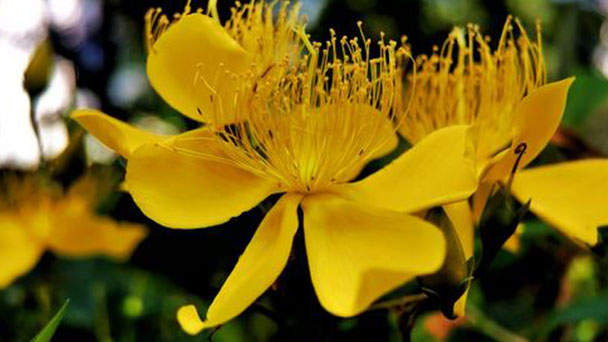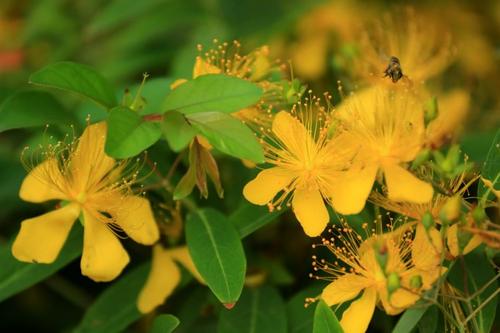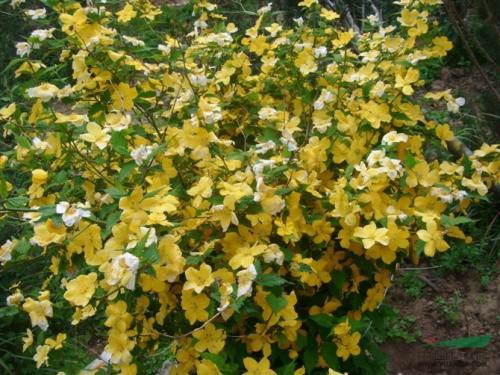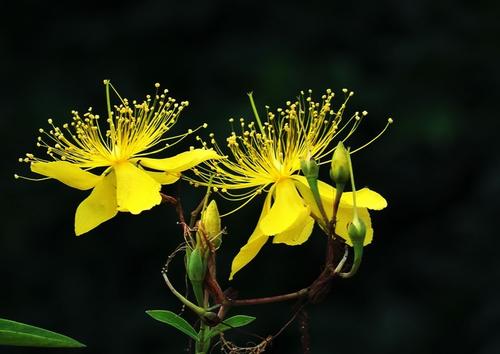St. Johns wort profile
Written by Maggie
Jan 18 2021

St. John's wort, also called yellow mosqueta, Hypericum patulum, is a gamineraceae semi-evergreen or evergreen shrub, branchlets red or dark brown. Leaves are opposite, ovate, long ovate, or ovate-lanceolate. Flowering period is from April to July, fruiting period from July to October.
St. John's wort picture

St. John's wort is one of the important flowering plants. It is a very precious wild ornamental shrub with large flowers, beautiful flowers and striking golden colors. The ornamental period is up to 10 months, suitable for planting in the courtyard, rockery and roadside, lawns and other places, can also be configured with special garden and flower path, but also potted ornamental, can also be cut flowers, is a good material for urban greening in the western region.
St. John's Wort features
Rhizome
St. John's wort is a small semi-evergreen or evergreen shrub, 0.3 -- 1.5 m tall, clusty, with spreading branches, sometimes slightly leafy. Stem is reddish to orange, 4-longitudinally or 4-prism when young, 2-longitudinally soon, sometimes finally cylindrical; Internodes are 0.8-4 cm long, shorter than or rarely longer than leaves; The cortex is grayish-brown.
Leaf
Leaves of St. John's wort petiolate, 0.5-2 mm long;Leaf blade lanceolate or oblong-elliptic lanceolate to ovate or oblong-elliptic ovate, 1.5 6 cm long, 0.5 3 cm wide, apex obtuse to rounded, often with small tips, base narrow or broadly cuneate to short gradually narrow, margin flat. It does not increase thick, hard paper, green above, the following is pale, the main lateral veins 3, midrib in branched above, tertiary veins sparse network and a few invisible, how many densely glandular, leaf blade glandular short line and dot.
Flowers
Inflorescences of St. John's wort with 1-15 flowers, from apex nods 1-2, corymbiform, sometimes apex first internodes short, sometimes with a few branchlets with 1-3 flowers in middle of stem; Pedicels are 2-4 (-7) mm long;Bracts narrowly elliptic to narrowly oblong, laggard. Flowers are 2.5-4 cm in diameter, more or less cup-shaped; Buds are broadly ovate-ovate, apex obtuse. Sepals are distinct, in bud and fruit when erect, ovate or elliptic or suborbicular to wide wide elliptic or oblong-elliptic to pour spoon oval, close range and other large or big, 5-10 mm long, 3.5 7 mm wide, apex obtuse to rounded or slightly concave form while very small tips, with fine tooth erosion of small teeth on edge to provide small tricholoma, membranous, often reddish, midrib, usually small veins not obvious or slightly, with most of the gland stripes.
Petals of St. John's Wort are golden yellow, without red, more or less incurved, oblong-ovate to broadly obovate, 1.2-1.8 cm long, 1-1.4 cm wide, about 1.5 -- 2.5 times as long as sepals, margin entire or slightly roasting denticulate, with a row of glandular dots near margin, a lateral micronate, apex of micronate more or less rounded to vanishing. Stamens have 5 bundles, each bundle has about 50-70 stamens, the oldest 7-12 mm long, about 2/5-1/2 of the length of the petals, anthers bright yellow.
Ovary is more or less broadly ovate-shaped, 5 -- 6 mm long, 3.5 -- 4 mm wide; Style is 4-5.5 mm long, ca. 4/5 to more than equal to ovary, more or less erect, curved apically; Stigma is not or hardly capitate.
St. John's wort is flowering from June to July.
Fruit
Capsule of St. John's Wort is oval-shaped in width, 0.9 -- 1.1 cm long and 0.8 -- 1 cm wide.
The seeds of St. John's wort are dark brown, more or less cylindrical, 1-1.2 mm long, with little or no keel-like processes and shallow threadlike honeycombs.
St. John's Wort fruit from August to October.
St. John's wort habits
St. John's wort likes to grow under the sparse forest on the hillside or valley and in the roadside or thickets. It can survive very well. As a temperate subtropical tree, it is slightly cold tolerant, but it also likes sunshine and has a little shade tolerance.
The root system of St. John's Wort is very well developed and germinative, and it can withstand pruning well. It has a strong sex, but is taboo to water, it grows in the area is generally well drained and is moist and fertile sandpaper loam.
Main value of St. John's wort
The Role of St. John's Wort: Viewing
St. John's wort has full branches and leaves, colorful flowers, gorgeous and lovely, can be planted in clusters or groups on the lawn, the edge of the tree altar, the corner, the roadside and so on. Also it is suitable for garden greening and potted ornamental.
Whether you're in the wild or at home, seeing a bouquet of golden flowers can give you a wonderful experience.

Functions of St. John's Wort: Medicinal
St. John's Wort is also a very good raw material for medicinal materials. Its roots can be used as Chinese medicinal materials, with the functions of relaxing muscles and promoting blood circulation, prolactin and diuretic.It is a kind of very good medicine.
St. John's Wort is different from ordinary medicinal materials. It has no toxic and side effects. People can eat it safely without worrying about what burden and damage it will cause to their body.
St. John's Wort high planting value
Generally speaking, flower friends choose a kind of plant, the first thing to consider is its ornamental aging, planting survival rate, management and maintenance requirements are not high and so on.
St. John's Wort belongs to the flowers with long ornamental period, high planting survival rate and simple management and maintenance. The soil only needs general rural soil to grow well, and the ornamental period is as long as 10 months. Whether it is planting, sewing or cutting, the survival rate of propagation is very high, which is very suitable for flower friends to keep at home, and it is a plant with very high planting value.
St. John's Wort growing methods
1. Soil: Although St. John's Wort is a plant with high economic value, medicinal value and ornamental value, it does not have high requirements for soil. It can grow well in shallow and poor soil.
2. Cultivation: Before planting at St. John's Wort, prune the roots and cut them flat to facilitate healing. When cultivating, the root system must be stretched, put the topsoil first, layered steadfastly, so that the root system and soil are closely combined. Surrounding the soil weir, immediately after planting enough water, 3 days after pouring the second time of permeation, a week after pouring again 1 permeation, to ensure survival.
3. Watering: St. John's Wort sprouts from germination to flowering period, as appropriate, water 2-3 times, and then water 2-3 times in summer drought, pay attention to drainage and waterlogging in the rainy season, avoid water.Pour antifreeze water once in winter.
4. Fertilization: Apply sufficient decomposed organic fertilizer before St. John's Wort cultivation, and then apply decomposed compost in trenches around the rhizosphere after falling leaves every autumn. In general, there is no need for topdressing in the growing season to avoid the branches' long and drooping, which will affect the ornamental effect.
Weeding: in order to make flowers and leaves lush, you need to strengthen the middle tillage weeding. In dry season and midsummer, soil should be loosened and weeded once every 2-3 weeks. After each irrigation, soil should be loosened in time to prevent soil hardening and improve soil permeability, so as to facilitate root growth and development.Weed every 2 weeks during the rainy season.
The propagation of St. John's Wort
St.John's Wort can be propagated by dividing plants, cutting propagation, sowing propagation, and tissue culture propagation when a large number of seedlings are needed.
1. Sowing method
St. John's Wort is carried out in the fruit ripening period from August to September every year. The St. John's Wort with good growth is selected for picking. After the capsule is dried, the seeds are rubbed and dried, and the pure seeds are obtained after air drying. Generally stored in bags at low temperature, soaking seeds in warm water for 1-2 days before sowing can significantly improve the germination rate of St. John's Wort seeds. It requires deep ploughing fine rake, apply sufficient bottom fertilizer, make 1.0-1.5 meters wide flat bed, waiting for sowing.
2. Cutting propagation
St.John's Wort is usually carried out in spring or autumn. One to two healthy branches are selected and cut into cuttings 10-15 cm long. The cuttings are flat on the top and inclined on the bottom. St.John's Wort seedbed should be watered permeable, cutting can be done after water lag, plant row spacing is 10 cm ×10 cm, inserting depth is 2/3 of the length of cuttings, irrigation, soil loosening, weeding is the main management.
With river sand or perlite as the cutting material, the cutting survival rate is higher; Cattle growth was better when the middle and upper parts of branches were used as cuttings. Indolebutyric acid treatment can promote the survival of cuttings and the growth of cuttings. When St. John's Wort cuttings were propagated, river sand or perlite was used as the cutting substrate, the middle and upper part of the new shoots were used as cuttings, and the indolebutyric acid treatment was used to obtain higher survival rate and higher quality of cuttings.
3. Plant division propagation
Propagation at St. John's Wort is usually done during spring or fall cultivation. Splitting must bring the earth ball, so conducive to survival. The root system of St. John's Wort can be wrapped in nylon bags or planted directly in flower pots. The root system of St. John's Wort should not be destroyed as far as possible. The root system should be packed while the root system is dug.
4. Tissue cultivation
Choose st. John 's wort was born young branches, in the water is rinsed clean, cut into 3 cm long, with filter paper absorb excess water, on the super net work with 70% alcohol for 20 seconds, washed with sterile water three times, and then turn into shock in 0.1% mercuric chloride solution for 5 minutes, rinse 5 times with sterile water, and then placed in high pressure sterilization had a small disk of filter paper, cut into 0.5 1.0 cm, containing a small bud stem section vaccination in differentiation medium for culture.

Latest Updated
- Benefits of Bugleweed - 7 Science-backed Health Benefits
- Bugleweed Dangers & Side Effects - Is It Poisonous?
- How to Plant Evergreen Trees - What You Should Know
- When to Plant Evergreens - Grow Guide for Evergreen Trees
- 12 Wonderful Evergreen Shrubs for Your Garden
- 12 Popular Evergreen Plants with Pictures for Beginners
- When And How To Prune A Lilac Bush Like a Pro
- How to Grow & Care for Lilac Vine (Hardenbergia Violacea)
- Japanese Lilac Tree (Syringa Reticulata) Care & Propagation Guide
- Shumard Oak Pros and Cons - What to Know
Popular Articles
- Winter maintenance of Antirrhinum Majus
- How to Grow Terminalia Mantaly Tree
- How to Grow and Care for Crossostephium Chinense
- How to grow Antirrhinum Majus in spring
- Peristeria Elata (Dove Orchid) Profile: Info & Care Guide
- Underwatered Snake Plant (Sansevieria Trifasciata) - Signs And How To Fix
- How to Care for Brazilian Jasmine Plant (Mandevilla Sanderi)
- How to Grow & Care for Graptopetalum Purple Delight in Summer
- Rosa Chinensis (China Rose): Plant Growing & Care Tips
- How to Care for Baby Sun Rose (Aptenia Cordifolia)